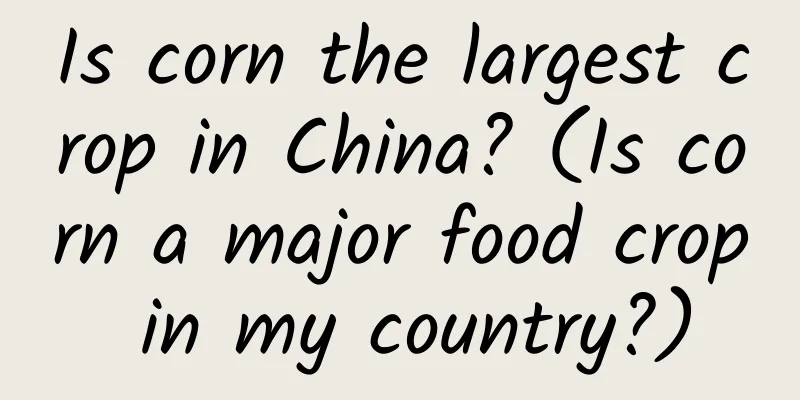Is corn the largest crop in China? (Is corn a major food crop in my country?)

Is corn a major crop in China?Corn is the largest grain crop in China and an important food crop as well as an important feed and industrial raw material. Since 2013, corn has surpassed rice to become my country's largest grain crop, with its output accounting for 38.9% of my country's total grain output. It plays a vital role in my country's agricultural production and national economy. Corn is currently the largest grain variety in China , one of the three major grain varieties and one of the four major staple foods. Although it cannot compare with the "absolutely safe" wheat and rice in terms of food security, it is also an important food crop that requires basic self-sufficiency. At present, the corn planting area in China has exceeded 600 million mu, making it the crop with the largest area and the highest total output , and it plays an important strategic role in ensuring China's food security. When was corn introduced into my country?Since corn was introduced to China in the Ming Dynasty , it has spread from South China, Southwest China, and Northwest China to all parts of the country. Because it was a newly introduced crop, each time it was promoted in a certain place, the local people gave it a name, so corn has many different names. In addition to being called fanmai, xitianmai, and yushushu, there are also names such as baogu, liugu, and yaolu . Current corn planting and development in my countryAs of 2018, the national corn plowing, planting, harvesting and comprehensive mechanization rates reached 97.33%, 88.73%, 75.85% and 88.31% respectively. In 2019, the mechanized tillage rate of corn is expected to reach about 97.8%, an increase of about 0.5 percentage points year-on-year; the machine sowing rate is expected to exceed 90%, an increase of about 2 percentage points year-on-year. The mechanized harvesting rate is expected to exceed 80%, an increase of about 5 percentage points year-on-year; the comprehensive mechanization rate is expected to exceed 90%, an increase of about 2 percentage points year-on-year. The application of full-process mechanized production technology for corn production has been accelerated, the number of machines and tools has continued to increase, and the level of mechanization has been steadily advancing. The results of full-process mechanization have begun to emerge. ① Comprehensive land preparation measures have been applied, and the quality of land preparation has been continuously improved.Problems such as "shallow tillage layer and thick plow bottom layer" and "corn not resistant to drought, waterlogging and lodging" caused by the long-term single rotary tillage land preparation method in the past have been alleviated. This has played a significant role in improving soil quality and increasing crop yields. The area of rotational tillage such as ploughing, deep loosening, and loosening and harrowing has been expanding year by year. ② The area of precision seeding has been further expanded, and the quality of seeding has been improved to a certain extentThe precision seeding method of corn has become dominant in the single-cropping areas of eastern North China and the double-cropping areas of the Huanghuai and Haihe River Basins, and the seeding quality has improved, especially the rapid development of no-tillage precision seeding technology. ③ High-ground clearance plant protection and drone plant protection technologies are developing rapidlyHigh-clearance plant protection machinery has been widely used in field production, and drone plant protection technology has developed rapidly. In 2014, there were 695 unmanned agricultural drones in China. By 2018, the number had reached 23,000, covering an operating area of about 300 million mu. However, agricultural drones still have problems such as insufficient load capacity and weak endurance. ④ The development of corn mechanized harvesting has shifted from high-speed growth to high-quality developmentMechanized corn harvesting in my country is mainly based on harvesting ears, with direct grain harvesting accounting for less than 10%. The current activities of promoting low-breakage mechanical direct harvesting technology for corn kernels and full mechanization of northern spring corn have effectively promoted the development of kernel harvesting technology. |
>>: Which month has the highest survival rate for rose cuttings (when can rose cuttings survive?)
Recommend
Are King Oyster Mushrooms Carbohydrates or Are Vegetables Carbohydrates?
King Oyster Mushroom is a kind of fungus vegetabl...
Maintenance methods of Jiyulu in four seasons
Spring maintenance The temperature is suitable in...
How to quickly root green radish cuttings (green radish cuttings method and care tips)
How to make the cuttings of green radish take roo...
How to trim bottle orchid leaves that are too long?
The bottle orchid is a unique foliage plant with ...
The efficacy and function of nectar
The efficacy and function of nectar What is Manna...
What are the cultivation methods and precautions of gentian flowers?
Gentiana cultivation method Gentiana belongs to t...
Can a fig tree be planted outside your home?
Can a fig tree be planted outside your home? Fig ...
Rose rooted and transplanted to a large pot died (how to transfer to soil culture after hydroponic rooting to increase the survival rate)
Why did the rose die after taking root and transp...
Are primroses poisonous? Can they be kept at home?
1. Is it poisonous? According to current cultivat...
How long is the growth cycle of a locust tree?
Sophora japonica growth cycle The growth cycle of...
How to plant pepper seeds
Pepper seed planting time Pepper seeds are genera...
When is the best time to sow rapeseed in the south?
Rapeseed sowing time in southern China Rapeseed i...
How long is the growth cycle of tea trees?
Introduction to Tea Tree Growth Tea trees origina...
How many days does it take for lettuce seeds to germinate
1. How many days does it take to germinate? Lettu...
Causes and treatments for yellow leaves of Jade Butterfly
1. Temperature discomfort Reason: Jade butterfly ...









